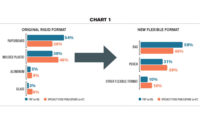The shift from rigid to flexible packaging is on – and has been on for some time. But to really get a more accurate picture of the details surrounding this shift, BNP Media’s Market Research Division, in conjunction with Flexible Packaging, has conducted an inaugural flexible trends study in an effort to measure and understand the recent rigid to flexible changes, the main drivers behind these changes and any obstacles that were encountered while undergoing these changes.
The study’s total sample was 28,283, and consisted of subscribers of BNP Media sister publications broken into two categories – Food & Beverage Packaging (FBP) and specialty food publications (SFP) Beverage Industry, Candy Industry, Dairy Foods, The National Provisioner, and Snack Food & Wholesale Bakery. The target audience was subscribers who work for a packaging supplier, co-packer or CPG that has changed packaging formats within the past three years. The study began on March 19 and closed on April 14.
Packaging Change Details
Of the FBP study participants, 79 percent stated that they made their most recent switch from rigid to flexible within the past two years, with 28 percent coming in the past six months, 18 percent coming in the past six to 12 months and 33 percent coming in the past 1-2 years. On the specialty food publications side, 41 percent have made the packaging change within the past six months, 24 percent within the past six to 12 months and 35 percent within the past 1-2 years.
So just what are participants switching to flexible from? Most respondents identified they’ve either switched from paperboard (FBP: 54 percent, SFP: 38 percent) or molded plastic (FBP: 38 percent, SFP: 46 percent) and transitioned to either bags (FBP: 59 percent, SFP: 46 percent) or pouches (FBP: 31 percent, SFP: 38 percent). See Chart I
According to respondents, the majority of rigid-to-flexible changes have been for food products, followed by beverage, retail and agriculture (See Chart II).
Driving the Change
As Chart I details, the majority of study participants revealed that they’re making the shift to bags and pouches from either molded plastic or paperboard packaging. Participants identified a variety of factors that are driving these changes – the most notable among those moving into bags being the cost savings associated with it. Other factors behind the shift from either molded plastic or paperboard to bags – from both the FBP and SFP participants – include:
- Better looking product
- Lighter weight
- Market demand
- Efficiency/productivity
- Materials reduction
- Time savings
Study participants from both the FBP and SFP groups expressed similar reasoning behind decisions to switch from molded plastic and paperboard to pouches. Reasons include:
- Better handling capabilities
- Cost savings
- Design attractiveness
- Increased shelf life
- Decreased shelf space
- Portability
- Consumer demand
The Packaging Change Process
Nearly all study respondents were involved to some degree in the packaging change process (See Chart III), and most expressed that the process was either “somewhat difficult” or “not very difficult” to implement (See Chart IV).
Generally speaking, the majority of participants expressed it was more difficult to switch to a bag than to a pouch. For instance, 53 percent of total respondents expressed the change to a bag was “somewhat difficult,” both in transitioning from molded plastic and paperboard formats. The majority of total respondents claimed the transition to a pouch was “not very difficult” from each leading rigid packaging format (See Chart V).
In making the transition, 34 percent of FBP respondents and 56 percent of SFP respondents stated that they acquired new equipment to make the change. Among new equipment acquired, baggers, flow wrappers, pouch fillers, and shrink tunnel and coalators were identified.










